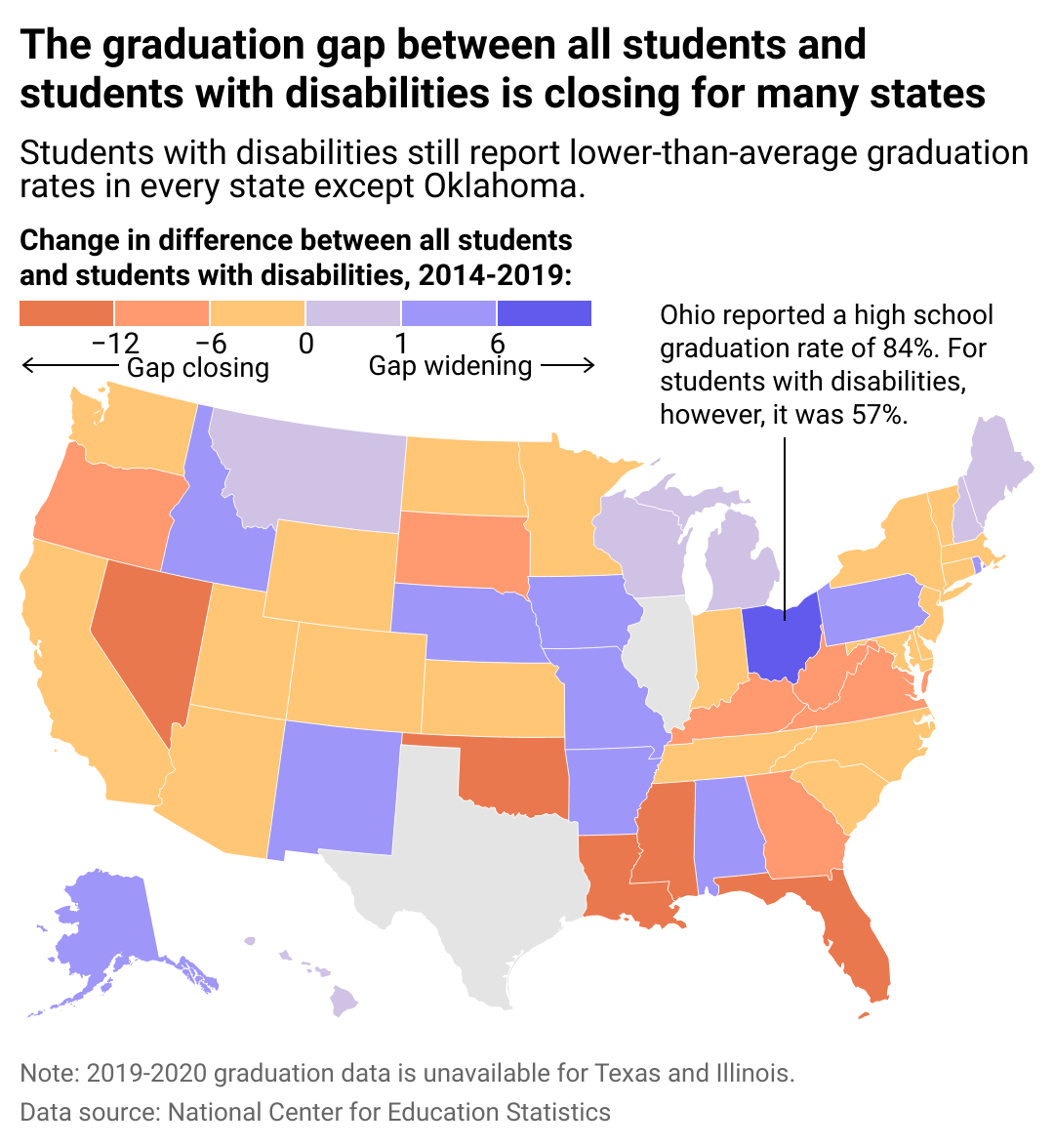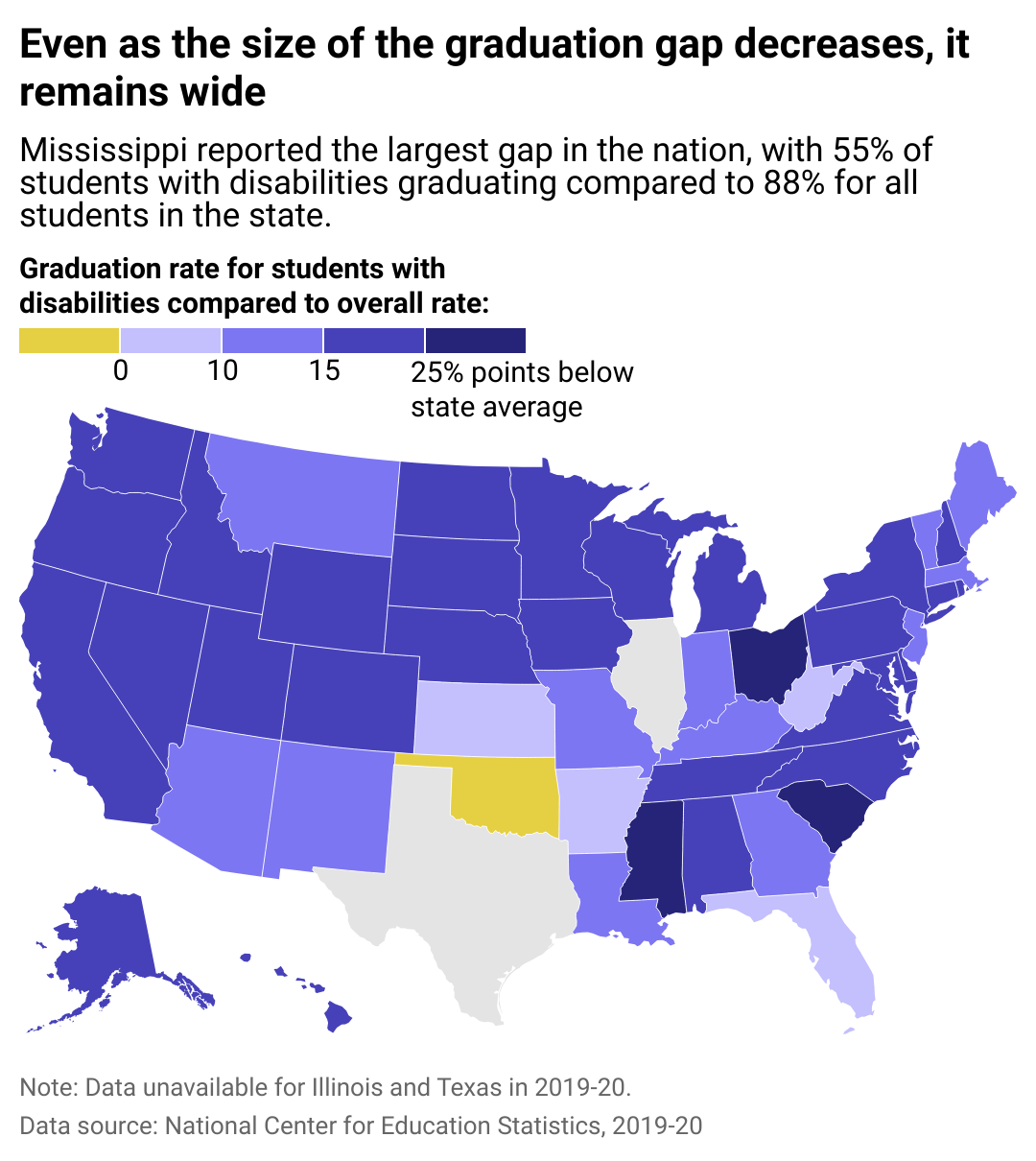Where graduation rates for students with disabilities are improving

Photo Illustration by Stacker // Canva
Where graduation rates for students with disabilities are improving
Black and white image of a colege graduate against a colorful backdrop of graduates tossing caps into the air.
The high school diploma is a rite of passage for many Americans. It comes with greater earning potential, improved employability, and creates a path to higher education. Still, not all children face the same barriers to graduating.
Students with disabilities represent 15% of public school students who, despite education reforms, are less likely to graduate on time or at all.
Marker Learning used data from the National Center for Education Statistics to explore how graduation rates for students with disabilities compare to overall rates from the 2014-2015 school year to the 2019-2020 school year.
Data from NCES reveals significant improvements in graduation rates for these students in the years leading up to the COVID-19 pandemic.
Nationwide, the graduation rate for students with disabilities was 71% for the 2019-2020 school year, up from 65% five years prior. Nonetheless, this was roughly 16 percentage points lower than that of the overall student population, an issue likely exacerbated by the pandemic.
Under the Individuals with Disabilities Education Act, an inclusive education law in the United States, public schools are required to provide support to students with disabilities from birth through high school. More than 8 million children with disabilities have benefited from IDEA, which Congress passed in 1975 with the understanding that disabilities are a “natural part of the human experience and in no way diminishes the right of individuals to participate in or contribute to society.”
Disabilities covered by IDEA can present in many ways, including specific learning disabilities like dyslexia, developmental disorders like ADHD, or other impairments that affect energy levels and alertness; autism spectrum disorder; depression and emotional disturbance; speech, hearing, and visual impairments; traumatic brain injuries; impairments to movement like cerebral palsy; and intellectual disabilities.
To qualify for inclusive education, it must be proven that any one or a combination of these disabilities makes learning difficult for the child, according to Understood, a nonprofit advocating for those with conditions that impact learning and thinking. However, 3 in 5 students in inclusive education spend 80% or more of their school days in classes with the wider student body, according to the NCES.
The No Child Left Behind Act, signed in 2002 by former president George W. Bush, is a more recent piece of legislation aimed at improving outcomes for students receiving inclusive education and children from low-income and racially underrepresented families. Though it is generally controversial and has mixed outcomes, it requires more accountability and transparency with achievement and graduation standards.
![]()

Marker Learning
Students with disabilities’ graduation rates are largely getting closer to overall averages
Map showing the closing graduation gap between all students and students with disabiltiies across the U.S.
This graduation rate gap is shrinking in most states. Oklahoma, Nevada, Florida, and Louisiana have seen some of the most dramatic improvements between 2014 and 2019, according to NCES data. Yet, despite progress, the gap still exists.
New York, for example, has lessened the disparity since 2014. According to the New York State Education Department, however, by 2020, around 3 in 5 students with disabilities graduated compared to more than 80% of the overall student population. And while a larger portion of students with disabilities remained enrolled after four years than before, a slightly greater portion dropped out compared to the overall student base.
The state has been working to improve those statistics by engaging with students’ families, providing inclusive activities, tailoring curriculum to student needs, and developing behavioral support systems.
States including Alabama, Idaho, Rhode Island, Nebraska, and Ohio are trending in the wrong direction. In response, Ohio rolled out an initiative using data-driven approaches to provide early warnings for students at risk of not graduating or dropping out.

Marker Learning
Progress still needs to be made
Map showing that even as the size of the graduation gap decreases, it remains wide. Mississippi reported the largest gap in the nation, with 55% of students with disabilities graduating compared to 88% for all students in the state.
In some states, the graduation gap between students with disabilities and the statewide average is as high as 25%. In Mississippi, where the disparity is greatest, nearly half of students receiving inclusive education don’t graduate, according to NCES. Experts and parents say systemic problems contribute, pointing to inadequately trained teachers, low expectations, and a lack of soft-skills training, like communication.
Roughly half of U.S. schools provide students with disabilities an alternate way to graduate. Twenty-seven states offer high school diplomas or altered tests, according to the NCES. However, those alternative routes aren’t always included in overall graduation rates and don’t guarantee the same job and higher learning opportunities.
The next few years will reveal whether, despite the aftermath of the pandemic, public schools not only managed to maintain the success they’ve built but further closed the gap between students receiving inclusive education and the rest of the student body.
Story editing by Shanna Kelly. Copy editing by Paris Close.
This story originally appeared on Marker Learning and was produced and
distributed in partnership with Stacker Studio.